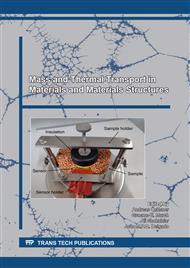[1]
B. Nambisan, Strategies for elimination of cyanogens from cassava for reducing toxicity and improving food safety. Food Chem. Toxicol. 49 (2011) 690-693.
DOI: 10.1016/j.fct.2010.10.035
Google Scholar
[2]
C.L.S. Chicherchio, Cassava and major derivatives. In: CONAB. Perspectivas para agropecuária: Safra 2014/15. Brasília, Brazil: CONAB. (2014) 106-117.
Google Scholar
[3]
V.R. Sagar, P.S. Kumar, Recent advances in drying and dehydration of fruitsand vegetables: A review. J. Food Sci. Technol. 47 (2010) 15-26.
DOI: 10.1007/s13197-010-0010-8
Google Scholar
[4]
E. Cabrera, N. Sanjuán, G. Panadés, L. Cruz, Influence of osmotic pretreatment on the convective drying of guava. Influence of osmotic pretreatment on the convective drying of guava. Int. Food Res. J. 23( 2016) 1623-1628.
DOI: 10.1080/07373937.2013.833518
Google Scholar
[5]
I. Ahmed, I.M. Qazi, S. Jamal, Developments in osmotic dehydration technique for the preservation of fruits and vegetables. Innov. Food Sci. Emerging Technol. 34 (2016) 29–43.
DOI: 10.1016/j.ifset.2016.01.003
Google Scholar
[6]
A. Vega-Gálvez, E. Lara, V. Flores, K. Di Scala, & R. Mondaca, Effect of selectedpretreatments on convective drying process of blueberries (var. O'neil). Food Bioproc. Technol. 5 (2012) 2797–2804.
DOI: 10.1007/s11947-011-0656-x
Google Scholar
[7]
R.C. Osidacz, M.C.B. Ambrosio-Ugri, Physicochemical quality of eggplant dehydrated with varied pretreatments. Acta Scient. Technol. 35 (2013) 175-179.
DOI: 10.4025/actascitechnol.v35i1.10551
Google Scholar
[8]
S. Kowalski, J.M. Łechtańska, Drying of red beetroot after osmotic pretreatment: Kinetics and quality considerations. Chem. Proc. Eng. 36 ( 2015) 345-354.
DOI: 10.1515/cpe-2015-0024
Google Scholar
[9]
A. Kaya, O. Aydin, S. Kolayli, Influence of osmotic dehydration on drying kinetics of carrot, J. Thermal Sci. Technol. 36 (2016) 155-162.
Google Scholar
[10]
D. Villada, H. Villada, A. Mosquera, Evaluating the effect of osmotic dehydration and frying in two varieties cassava (Manihot esculenta Crantz) in the production of chips. Dyna.76 (2009) 160.
Google Scholar
[11]
F.A. Ortega, E.J. Montes, Kinetic parameters of mass transfer in deep-fat frying of cassava slices (Manihot esculenta Crantz). Ingeniería y Competitividad. 16 (2014) 1-24.
Google Scholar
[12]
T.R.B. Pessoa, Optimization of the osmo-convective dehydration of cassava cubes. Doctoral Thesis in Process Engineering. Federal University of Campina Grande, Campina Grande, Brazil. 2018. 195f. (In Portuguese).
DOI: 10.21475/ajcs.2016.10.10.p7455
Google Scholar
[13]
AOAC (Association of Official Analytical Chemists): Official methods of analysis. 16th ed. Washington, USA (1995).
Google Scholar
[14]
G.H. Jeffery, J. Basset, J. Mendham, R.C. Denney, Vogel´s textbook of quantitative chemical analysis. 5 ed., Longman Scientific & Technical, England (1989).
Google Scholar
[15]
H. Lane, L. Eynon, Determination of reducing sugar by means of Fehling's solution with methylene blue as internal indicator, J. Society Chem. Ind., London 42 (1923) 32T-37T.
Google Scholar
[16]
C.G. Moyers, G.W. Baldwin, Psychrometry, Evaporative Cooling and Solids Drying. In: Perry, R. H., Green, D. W. (eds.) Perry's Chemical Engineers' Handbook. 7 th ed., , Mac Graw-Hill, Nova York (1999) 12-1: 12-90. (CD-ROM).
Google Scholar
[17]
Statsoft. Statistica for windows, Tulsa, USA (1997).
Google Scholar
[18]
D.E. Montgomery, Introduction to Statistical Quality Control. Sixt edition, John Wiley and Sons, New York (2008).
Google Scholar
[19]
M.C.S. Nogueira, Agronomic experimentation I- concepts, planning and statistical analysis. Esalq, Piracicaba (2007). (In Portuguese).
Google Scholar
[20]
J. Crank, The Mathematics of diffusion. 2. ed. Clarendon, Oxford (1975).
Google Scholar
[21]
T.R. Bezerra Pessoa, A.G. Barbosa De Lima, P. Correa Martins, P.V. Campos, A. Silva do Carmo, E. da Silva, Osmotic Dehydration of Cassava Cubes: Kinetic Analysis and Optimization. Diff. Foundations 25 (2020) 99 - 113.
DOI: 10.4028/www.scientific.net/df.25.99
Google Scholar
[22]
T.R. Bezerra Pessoa, A.G. Barbosa de Lima, P.C. Martins, V.C. Pereira, Osmo-convective Dehydration of Fresh Foods: Theory and Applications to Cassava Cubes. In: Delgado J., Barbosa de Lima A. (eds) Transport Processes and Separation Technologies. Advanced Structured Materials,. Springer, 133 (2021) 151-183. Cham. https://doi.org/10.1007/978-3-030-47856-8_6.
DOI: 10.1007/978-3-030-47856-8_6
Google Scholar
[23]
J.R.J. Junqueira, J.L.G. Correa, K.S. Mendonça, Evaluation of the shrinkage effect of sweet potato, J. Food Process. Preserv. 41 (2017) 1-10.
Google Scholar
[24]
L.M. Pereira, C.C. Ferrari, S.D.S. Mastrantonio, A.C.C. Rodrigues, M.D. Hubinger, Kinetic aspects, texture, and color evaluation of some tropical fruits during osmotic dehydration, Drying Technol., 24 (2006) 475-484.
DOI: 10.1080/07373930600611968
Google Scholar
[25]
A.S. Carmo, T.C.O. Alves, P.C. Martins, Study of the kinetics of osmotic dehydration of manioc slices, Rev. Braz. Agrotechnol. 7(2017), 266-272. (In Portuguese).
Google Scholar
[26]
J.E.F. Aires, W.P. Silva, K.L.C.A.F. Aires, A.F.S. Júnior, D.S. Castro, C.M.D.P.S. Silva, Guava osmotic dehydration: description by two-dimensional diffusion models considering shrinkage and variations in process parameters, Int. J. Food Eng., 12 (2016) 527-536.
DOI: 10.1515/ijfe-2016-0056
Google Scholar
[27]
D.S. Castro, J.S. Nunes, A.F.S. Júnior, J.E.F.A. Aires, W.P. Silva, J.P. Gomes, Influence of temperature on the process of dehydration osmotic pieces of guava, Rev. GEINTEC, 4 (2014) 1413 -1423. (In Portuguese).
DOI: 10.7198/s2237-0722201400050010
Google Scholar
[28]
E.O. Akoy, M. Experimental characterization and modeling of thin-layer drying of mango slices, Int. Food Res. J., 21 (2014) 1911-1917.
Google Scholar
[29]
E. Cabrera, N. Sanjuán, G. Panadés, L. Cruz, Influence of osmotic pretreatment on the convective drying of guava, Int. Food Res. J. 23 (2016) 1623-1628.
Google Scholar
[30]
Brazil. Ministry of Agriculture, Livestock and Supply. Normative Instruction n° 23, December 14, 2005. Approves the Technical Regulation on Identity and Quality of Starchy Products derived from cassava root. Official Journal of the Federative Republic of Brazil, Brasília p.5 Section 1 (2005). (In Portuguese).
Google Scholar


